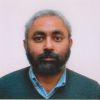
Dr Samit Chakrabarty
- Position: Lecturer
- Areas of expertise: sensory motor neurophysiology; medical technology; closed loop stimulation systems; rehabilitation
- Email: S.Chakrabarty@leeds.ac.uk
- Phone: +44(0)113 343 4256
- Location: G5.55b Garstang
- Website: http://www.translate-medtech.ac.uk/translate-me/innovation-champions/ | X | LinkedIn | Googlescholar | Researchgate | ORCID | White Rose
Profile
I am a systems neurophysiologist, studying plasticity and interaction between the spinal circuits and their modulators - the sensory inputs from periphery and descending inputs from brain.
PhD - University of Cambridge; Postdoc - Columbia University, NYC; Spinal Cord Research Centre, Winnipeg, Canada; Visiting Associate Professor - Panum Institute, University of Copenhagen; Research Associate Professor - Columbia University, NYC
Motor action and role of spinal interneurones
A motor act is successful when an organism evades a predator, catches a prey, plays the violin or hurls insults. Motor action is only possible when the spinal motor effectors or motoneurones are active. To actively adjust their output depending on the need during a task, requires that these motoneurones are modulated, from moment to moment, either by feedback from the periphery or feedforward commands from the higher brain structures. These regulatory inputs and their effect on the motoeneurones is what we study in my group, for both walking and reaching in humans and in animal models of developmental disorders and ageing. The ultimate goal is to decipher the underlying operating principles, which can then be used to better the therapies and interventions towards restoring motor control in people suffering from movement disorders.
Modulation of spinal motor output by inputs from brain and periphery
Responsibilities
- Translate Innovations Champion
- MRes Neuroscience Programme
- Executive member of Robotics at Leeds
Research interests
Interests https://www.researchgate.net/profile/Samit_Chakrabarty
Neurophysiology of Motor control Neuroscience
Rehabilitation Robotics https://robotics.leeds.ac.uk/profiles/
Current projects:
- Reflex reorganisation during development, post injury and ageing
- Spinal cord injury and restoration of voluntary control
- Development of smarter neuroprosthetics
- Development of more efficient multichannel recording and stimulating devices
- Systematic analysis of the neuronal architecture of the spinal cord and brain related to motor control
- Application towards development of neuroprosthetics.
Techniques:
- In-vivo electrophysiology - intracellular and extracellular recordings
- Human neurophysiology and rehabilitation - Mobility disorders, sEMGs
- Medical devices for imrpoved recording and stimulation
- Tools to improve deliverly of drugs and modulation of the signal for implantables and wearables
- Mathematical modelling
- Immunohistochemistry
Translational research
BIOMEDICAL RESEARCH developing new diagnostic tools for neurologists and undertsanding neurological dysfunctions like stroke, parkinson’s disease and Cerebral Palsy.
MATHEMATICAL MODELS OF BIOLOGICAL SYSTEMS. We are using the data generated from our biological experiments and developing a stochastic model. This allows to examine likely interactions between populations leading to changing motor outputs which are then verified experimentally.
APPLICATIONS. We work with muliple groups to develop better smarter tools to imrpove current technology to make these affordable, modular and easier to use for most across the globe.
COLLABORATORS:
- Dr Lena Jespersen (Leeds University Business school) – Global challenges in disability databases and community based rehabilitation
- Dr Ronaldo Ichiyama (FBS) – Spinal cord injury models and rehabilitation in animal models
- Dr Marc de Kamps (Computing) – Mathematical modelling of the mammalian motor system
- Dr Sarah Astill (FBS) – Spinal cord injury models and rehabilitation in people
- Dr Jongrae Kim (Mechanical Engineering) – Mathematical optimisations
- Dr Mehmet Dogar (Computing) – Human robot interfacing
- Dr Muhammad Tausif (School of Design) – Artificial muscles
- Prof Shane Xie (Mechanical engineering) – Rehabilitation robotics
- Dr Paul Steenson (Electronics Engineering) – Development of new devices and tools for biomedical and clinical use
- Prof Xingyu Jiang (SUSTECH, China) – Development of new recording and stimulation systems
- Dr Kevin Power (Memorial University, Canada) – Motor synergies and dysfunction and rehabilitation
- Dr Preeti Raghavan (Johns Hopkins University, US) – Motor dysfunction and rehabilitation in people
Our research is supported by the GCRF, EPSRC, BBSRC, the International foundation for research in paraplegia, International Spinal Research Trust, Craig Nielsen Foundation and The Royal Society.
I am a Innovation Champion as part of the Univeristy's partnership with Translate:, on-hand to offer advice about technology progression and enhance innovation skills and capabilities - http://www.translate-medtech.ac.uk/translate-me/innovation-champions/
Qualifications
- PhD (Cantab)
Student education
I am a programme leader for Masters by research in Neuroscience
I also teach on many other modules in the school of biomedical sciences, and across other schools and faculties.
Undergraduate project topics:
Systematic analysis of the neuronal architecture of the spinal cord and brain related to motor control, application towards development of neuroprosthetics. Techniques: Systems neurophysiology, Immunohistochemistry, Mathematical modelling
Postgraduate studentship areas:
- Reflex reorganisation during development, post injury and ageing
- Spinal cord injury and restoration of voluntary control
- Development of smarter neuroprosthetics
- Development of more efficient multichannel recording and stimulating devices
See also:
- Faculty Graduate School
- FindaPhD Project details:
Research groups and institutes
- Neuroscience and Behaviour
- Sport and Exercise Sciences
- Motor Control and Rehabilitation
- Biomedical Technologies
- International students
Projects
-
<li><a href="//phd.leeds.ac.uk/project/1917-exploring-sensorimotor-function-and-developing-rehabilitation-strategies-using-experimental-and-computational-approaches">Exploring Sensorimotor Function and Developing Rehabilitation Strategies using Experimental and Computational Approaches</a></li>

